Lesson 1
Before jumping straight into the conversation about project development and planning, it's worth brushing up a bit on our understanding of planning itself. The essence of planning is to set goals and determine ways to achieve them by creating a set of activities and actions necessary for implementation, using the methods and ways of implementing activities and actions, linking the resources required to perform and coordinating the functions performed by project participants. It is with the issue of planning that we will begin the first lesson (we will immediately make a small reservation: there is a lot of information on the development and planning of projects, so we will present it in a concentrated form, dwelling in detail only on the most important points).
Project planning
The work of drawing up a plan includes all stages of creating and implementing a project. It begins with the development of the project concept by the leader (project manager), continues with the selection of strategic decisions, the development of details, the conclusion of contracts and the execution of works, and ends with the completion of the project.
At the planning stage, the main parameters for the implementation of the project are established. These include:
- The duration of each controlled element of the project
- The need for resources (financial, logistical and labor)
- Terms of delivery of the necessary equipment, components, materials, raw materials, etc.
- Terms and volumes of involvement of organizations (construction, design, etc.)
Any process and any procedure for planning a project must ensure that the project is carried out on time and in compliance with all requirements, including cost, standards and quality. In addition, in a well-organized project, a separate body should be responsible for the performance of each function and the achievement of each goal: for the mission of the project - the project manager, for private goals - responsible persons, etc. It is for this purpose that it is customary to develop a responsibility matrix that defines the functionality of the performers and specifies the complex of their work.
The higher the level of the governing body, the more generalized it makes decisions on the management of lower divisions. As the hierarchical level rises, the time intervals between setting tasks, monitoring their implementation, etc. increase. During these intervals, subordinate units must work independently and regardless of their equal units. Their independent work is provided by reserves of resources, which also need to be planned.
The main goal of planning- this is the construction of a model for the implementation of the project, necessary for coordinating the actions of the persons involved in the project. Thanks to this model, the order in which work will be carried out, etc. is established.
At the first stage of project planning, initial plans are developed that serve as the basis for compiling the project budget, determining resource requirements, organizing project support, etc. Planning always precedes control and is considered the basis of its application, because. allows you to compare planned and actual indicators.
Planning is the most important process for the project, because the result depends on it. The scope and detail of planning depends on the usefulness of the information that can be obtained during the implementation process and is determined by the intent of the project itself. The planning process cannot be fully automated, because it has a lot of variables. Plus, it can be influenced by random factors.
In addition to everything, project planning consists of a number of main and auxiliary processes.
Main processes (always present):
- Planning, documenting and describing the scope of the project
- Determining the main stages of the project implementation and breaking them down into smaller components
- Budgeting and estimating the cost of resources required to implement the project
- Defining and drawing up a step-by-step action plan that ensures the project
- Determination of the work sequence
- Determination of technological dependencies and restrictions on work
- Estimate the duration of work, labor costs and other resources required to complete individual tasks
- Resource planning (determining the type of resources for project work and their scope)
- Determining the timing of work under the condition of limited resources
- Formation of the budget and linking the costs according to the estimate to specific types of work
- Project plan development
- Collecting the results of other planning processes and linking them into a single document
Auxiliary processes (present as needed):
- Planning and setting quality standards and identifying ways to achieve them
- Organizational planning, including the definition and distribution of functionality, responsibilities and subordination norms
- Selection of people necessary for the implementation of the project and team building
- Establishing the communication and information needs of project members
- Identification, assessment and documentation of project risks (determination of uncertainties and the degree of their influence on the project, determination of favorable and unfavorable scenarios for the project implementation)
- Logistics planning (what, when, where and how to procure and deliver)
The plans (networks and schedules) that are the results of planning should eventually line up in a pyramidal structure that includes all the necessary information, differentiated by levels, deadlines, etc. Project planning and systematization of plans are built on the principles of "feedback", which ensure regular comparison of planned and actual information and make the work more efficient, relevant and flexible.
Project Planning Principles
Decisions made and actions taken in the field of project planning are based on several important principles:
- The principle of purpose. It is expressed in the fact that the project is aimed at achieving the ultimate goal of the project initiator (a person, a group of people, an organization, etc.)
- The principle of system. It assumes that the project is managed as a whole with its own characteristics of formation and development, but at the same time can be divided into subsystems with their subsequent study, because. they are all interconnected and affect each other and the entire project. This allows you to find and create useful links between subsystems and their effective relationships, to present qualitative and quantitative assessments of the process of implementing the entire project and its individual elements.
- The principle of complexity. According to it, phenomena are considered taking into account their dependence and connection, different methods and forms of management are applied, the entire set of project management goals is considered at various levels and in various links, individual elements are linked to each other and correlate with the main goal of the project.
- Security principle. It means that all activities envisaged by the project must be equipped with all the resources required for their implementation.
- The principle of priority. He says that in the development of the project and its implementation, the main attention should be paid to the primary tasks due to the general concept of strategic development.
- The principle of economic security of planned activities. Economic security should be calculated based on the probability of losses and damages as a result of the failure to implement the event planned by the project. No innovations in work can exclude risk, which is why in the practice of developing and planning a project one should not avoid risks, but consciously take justified risks in order to reduce them to the maximum possible level.
In addition to the principles that we have named, it is also important to take into account the consistency of the tasks and interests of all persons involved in the development and implementation of the project and the timeliness of achieving the goals set on time.
Taking into account the peculiarities of project planning and the above principles, we can proceed to the next equally important issue - the division of design work into components.
Work breakdown structure, responsibility matrix, cost items
The work breakdown structure (WBS) is a hierarchical structure of the sequential breakdown of the project into subprojects and sets of detailed works of different levels. CPP is the main tool for creating a project management system that allows you to solve various organizational problems, allocate responsibility, estimate costs, create a reporting system, support the collection of work progress data and display their results. Also, with the help of CPP it is convenient to coordinate the project plan with the needs of the customer.
For the project manager, the CPP is no less important, because allows:
- Determine the work and work packages to achieve intermediate goals
- Be aware of whether all project goals will be achieved
- Create a suitable reporting structure
- Define project progress milestones
- Allocate responsibility among performers
- Provide team members with an objective understanding of all project goals and objectives
Complexes (packages) of work correspond, as a rule, to the lower level of detail of the CPP and include detailed work, which in turn may consist of steps. Detailed works and steps are not elements of the CPP.
RBS can be developed top-down (from the main to the specific) and bottom-up (from the specific to the main), or using both approaches. Information for the development of CPP can be identified using . The final CPP should take into account all the goals of the project and the prerequisites for its implementation.
The detail of the CPP depends on the content of the project, the experience and skills of the team, the management system, the principles of distribution of responsibility, the reporting system, etc. To create CPP, functional and technical specifications are often used with general requirements for work.
Due to the hierarchical structure of the project, which is based on the CPP, it is possible to use procedures for collecting and processing data on the progress of project work in accordance with milestones, work packages, etc. It also allows you to summarize information by time, resources, costs, and schedules.
The drafting of the CPP can be built on the following grounds:
- Stages of the project life cycle
- Features of the organizational structure
- Components of the result (goods, services, etc.) obtained after the implementation of the project
- Functional or process elements of the activities of the organization that implements the project
- Geographic location (if projects are spatially distributed)
In practice, combined COPs are almost always used, created using several bases, and the COP should include all the activities of the project, including detailed activities and steps.
One of the most important stages in the construction of the CPP is the analysis of its completeness, so if the project has works that are controlled not only by the project manager, but also by the customer, they should also be included in the CPP - this will ensure the completeness of the structure.
Taking into account the information on the plan of project activities, the CPP is divided according to the criteria and features of the project. The breakdown occurs until all the important works and elements of the project are identified so that it is possible to plan them, determine their budget, draw up a schedule and action plan for their control. To simplify and automate the CPP, all of its elements must be assigned an identifier corresponding to the level number. The identifiers should reflect the criteria for splitting work.
It is equally important to avoid a number of mistakes when structuring a project, namely:
- Skip the structuring stage and move on to finding solutions to current problems
- Use only organizational units, phases or functions in the structuring process, not end products or resources applied
- Forget about the fact that one hundred CPP should cover the entire project, omitting the initial and final phases of the project and the work of individual departments
- Repeat structure elements
- Forgetting to integrate the project structure with the project documentation system and financial reporting system
- Excessive or insufficient detail of the structure
- Create a structure so that it is not subject to computer processing (all elements or levels of the plan must have the appropriate encoding)
- Do not take into account "intangible" final products, for example, services, services, etc.
CPP is the basis for understanding by team members the essence and dependencies of design work, which ensures the subsequent coordinated and coordinated work of all departments.
The Responsibility Matrix mentioned above and the Organizational Structure Chart (CCO) implementing the project are two tools that help the project manager build a team that is consistent with the goals and objectives of the project. The use of CCO and CRR in the construction of the responsibility matrix is clearly displayed in the figure below:
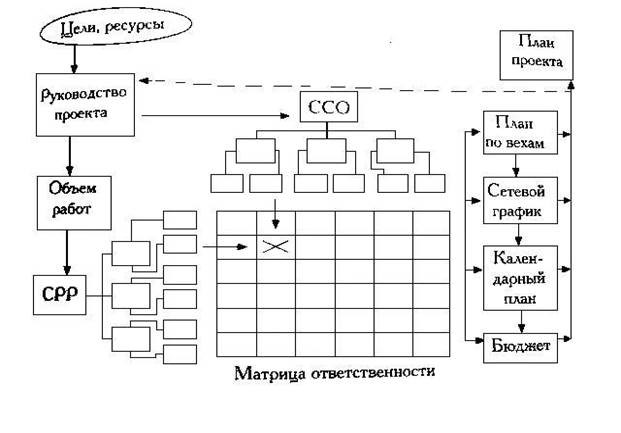
The composition and plan of the project work to a large extent affect the form of the organizational structure necessary to achieve the goals of the project.
The responsibility matrix allows you to provide and agree on the structure of responsibility of team members (divisions) for the performance of work. In fact, this is a form of description of the distribution of responsibility for the implementation of design work, which indicates the roles of team members and / or departments. One axis of the Responsibility Matrix displays a list of CPP work packages, and the other axis displays a list of performers responsible for their implementation.
The elements of the matrix are codes for the types of work from a list compiled in advance (you can also enter the cost of work into the matrix). The scope of the responsibilities depends on the specifics of the project and its organization, but it is recommended to use a small set of activities that are easy to understand and describe. Below is an example of a responsibility matrix:
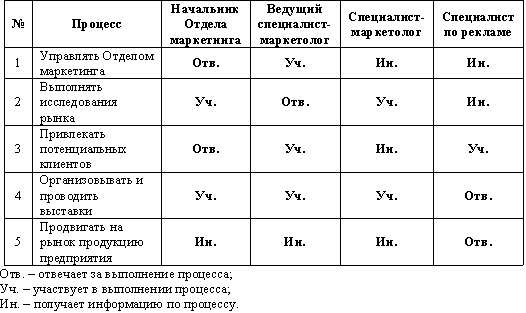
The responsibility matrix can display the types of responsibilities of managers and the roles of people who help in the implementation of the project, but do not directly participate in this. If properly designed, the matrix can be an excellent tool to ensure both efficient execution of work and successful support by internal and external resources.
Persons responsible for the execution of work are appointed during the planning of the project, because it is necessary to have an idea of available resources even before taking action to implement the plan. After defining the resources, it is necessary to determine how they can be obtained; in particular, this applies to labor resources.
The appointment of employees is carried out in stages - first a working group is formed, and then the project team, because it is the working group that will become the backbone of the future team. The composition of the working group is determined by the tasks and goals of the project. Almost always, the group consists of managers, influential members and key personnel.
The working group takes part in the initiation of the project and its planning. At this stage, it is not yet possible to determine the resources, because only general information about the project is available, and more detailed data will be obtained after the detailed work is carried out and the SRR is created. The final appointment of performers and the definition of their functionality will take place only after the final development and approval of the plan.
To correctly assign responsible persons, you need to be aware of several types of resources that can be used:
- Human Resources
- Financial resources
- Equipment
- Technical equipment
- Technology and information
- Suppliers and materials
Despite the fact that performers do not always have all the levers for managing and using resources, knowing the seven types of resources greatly simplifies the process of describing a project and deciding on the distribution of responsibility, because, as already mentioned, work packages must be provided with everything necessary for their implementation. . To do this, it is important to answer two questions:
- What specific resources are required for the implementation of all project activities (a list of requirements can be obtained using the work schedule and CPP)?
- What is needed already?
Once the answers to these questions are received, the final distribution of responsibility can be made.
Here we must also talk about an additional means of planning design work - the structure of cost items. It should not be confused with accounting accounts, because. according to the articles included in it, there is a classification and collection of unconfirmed documented management information necessary for making management decisions (meaning that there is no documentation confirming the actual costs, but there is preliminary data on the resources used, work performed, etc.).
Line items are a management tool that is used to collect data on the actual costs of work performed and then compare them with the planned costs. The same articles apply to planning and time and cost control, as include information about the work assigned based on the CPP. Below you can see an example of the formation of cost items for work packages for which specific departments are responsible (based on the CPP):
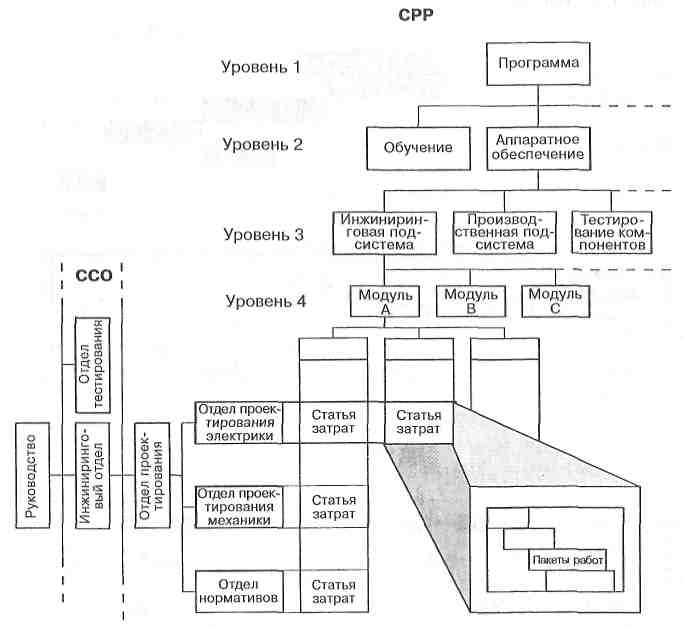
Cost items may include data for multiple work packages based on various criteria, such as:
- Responsible persons
- Account structure
- Deadlines
- Content of works
Summing up all the above about cost items, it remains only to note that they contribute to the formation and monitoring of the project budget, the implementation of current management accounting and the assessment of possible costs after the completion of design work.
Now we can move on to consider the most effective methods of project planning to ensure the timely implementation of both the project as a whole and its individual stages.
Network project planning
Network project planning methods or, as they are also called, network diagrams (network graph, PERT diagram) are a graphical display of design work and the dependencies between them. The concept of "network" here means a complete set of works and control points of the project with established dependencies between them.
Network diagrams display a network model as a graph with a series of vertices that correspond to jobs, and lines connecting them show the relationships between these jobs. A graph, often referred to as a precedence-follower diagram or node-to-work network, is considered the most common representation of a network. Below you can see an example of a fragment of such a graph:
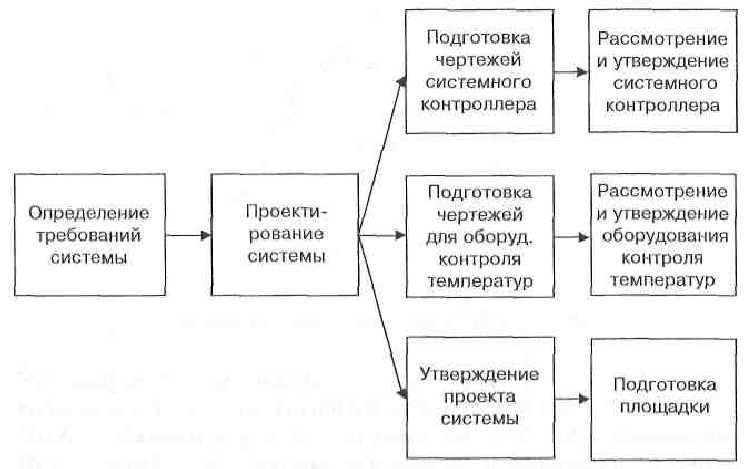
There is also a type of network diagram called a vertex-event network, but in practical work it is not used so often. In this case, the work has the form of a line connecting two events (graph nodes) representing the beginning and end of a certain work. A good example of such a chart is the PERT chart - here it is:
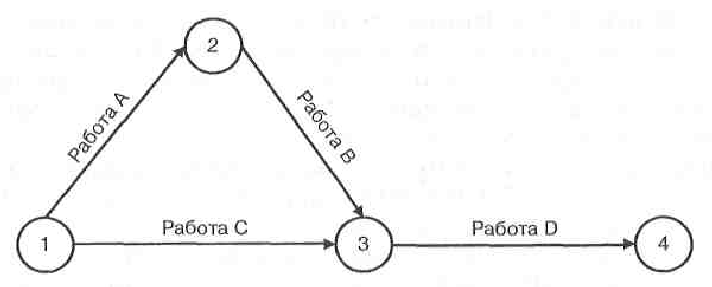
Network diagrams are often confused with flowcharts, but this is not entirely true, because. The difference between a network diagram is that it displays only the logical dependencies of work, while a flowchart shows inputs, outputs, and processes. Also, there are no repeating cycles (loops) in the diagram.
Network planning methods are methods aimed at minimizing the duration of the project. They are based on the critical path method (ICP or CPM (from the English. Critical Path Method)) and the method of evaluation and revision of plans (PERT (from the English. Program Evaluation Review Technique)).
The critical path is the longest path in the network, and the activities on this path are called critical. The minimum duration of design work depends on the duration of the critical path. The overall duration of a project can be reduced by reducing critical activities. Thus, delays in the execution of work entail an increase in the duration of the project.
With the critical path method, you can calculate approximate work package schedules based on the network logical structure and individual work time estimates, and establish an overall critical path for the project.
There is also the concept of a full reserve (reserve) of time. This is the difference between the late and early start or finish dates of the work. The managerial nature of the slack is that there is room for financial, resource, or technology constraints to be resolved, and the project manager can pause work for the amount of slack without fear of adversely impacting the project's deadline. The slack for critical work is zero.
A horizontal line chart, where project tasks are represented by time periods with specific time parameters (start, finish, delays, etc.) is called a Gantt chart, and it is also an integral part of network planning. Here is her example:
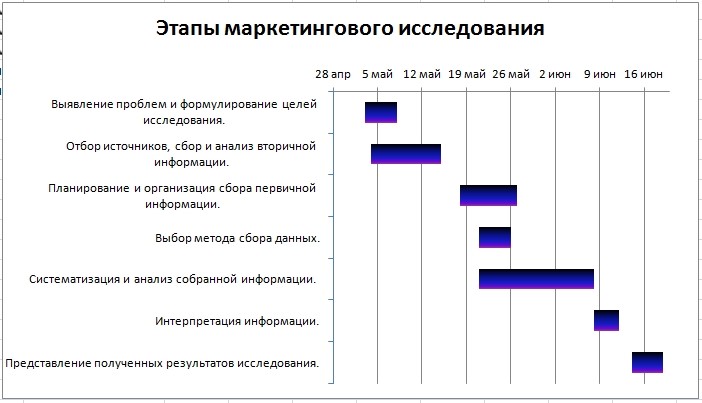
For effective planning, it is convenient to use PERT charts, a network graph, and a Gantt chart. Network planning itself implies a description of all project work in the form of a set of works with specific relationships between them. To calculate and analyze a network graph, a set of network operations, called critical path method procedures, is usually applied.
The network model is being developed in stages:
- Design work lists are defined
- Work parameters are evaluated
- Establishes dependencies between jobs
Work lists should be defined to describe all project activities, including all details. Work is the main element of the network model. Work packages define the activities that must be carried out in order to achieve project results. The results are usually highlighted by breakpoints.
Before developing a network model, you need to make sure that the lower level of the CPP includes all the activities that guarantee the achievement of private project goals. The network model is the result of determining dependencies between activities and adding connecting events and activities. In its most general form, the presented approach is based on the assumption that any work is designed to help achieve a particular goal. Linking work does not necessarily have to be aimed at achieving a material result, because. their purpose may be to organize an event, etc.
The main task of the project manager is to evaluate the parameters of the work. For this, other project participants responsible for the implementation of individual tasks of the project may be involved. Estimating the duration of work and the need for funds and resources most directly affects the relevance of resource and cost plans and schedules that are compiled after analyzing the network model. Such an assessment should be carried out for each of the works. Then, on its basis, the CPP levels in the project plan are summarized and formed.
In order for the individual stages of the project and the entire project to be implemented in a timely manner, it is also necessary to plan the project according to time parameters. Let's consider this question in more detail.
Project planning by time parameters
Time parameters should be understood here as the time periods during which the work and work packages are planned to be completed, as well as the control points of the project implementation process. Time is the most important factor affecting the effectiveness of the implementation of the entire plan.
The timing of the implementation of the elements of the project and the entire project is always planned in advance, and, of course, it is desirable to minimize them. But minimization of terms is limited by three parameters: technical capabilities, technological requirements and quality of work. All this should be taken into account when planning.
Planning by time parameters is a key element of project management, which includes several components. These components are:
- The concept of project management by time parameters
- Project scheduling
- Monitoring the progress of design work
- Analysis and settlement of the progress of work
- Closing project management
It is often difficult to complete a project on time. The reason for this is a fuzzy understanding of what exactly needs to be managed, and most of the problems arise even at the planning stage.
The reason for discrepancies with the schedule may be delays in deliveries, lack of resources, etc. If the scope and subject areas of the project are incorrectly defined, then adjustments will have to be made to the work and the schedule.
When a manager deals with typical repetitive projects, it is convenient to accurately determine the time and sequence of actions, although in practice projects are rarely repeated.
If we talk about the causes of temporary losses in the project, then they include:
- Poor quality management and budgeting
- No contingency plan for unexpected costs
- Poor distribution of risks among project participants
- Lack of structure in the communication system
- Difficult project reporting system
And another important component of project management in terms of time parameters is the management of personal time resources. This is relevant for each performer and project participant, but more important for the manager, because he is responsible for the success of the project, which means that he needs to have time to do a lot of all kinds of work.
To improve personal time management, it is desirable to use the so-called forms. The form is a list of work required for completion, indicating the performers and deadlines. The highest priority work should be transferred to temporary blocks of the planning calendar. The planning calendar might look like this:

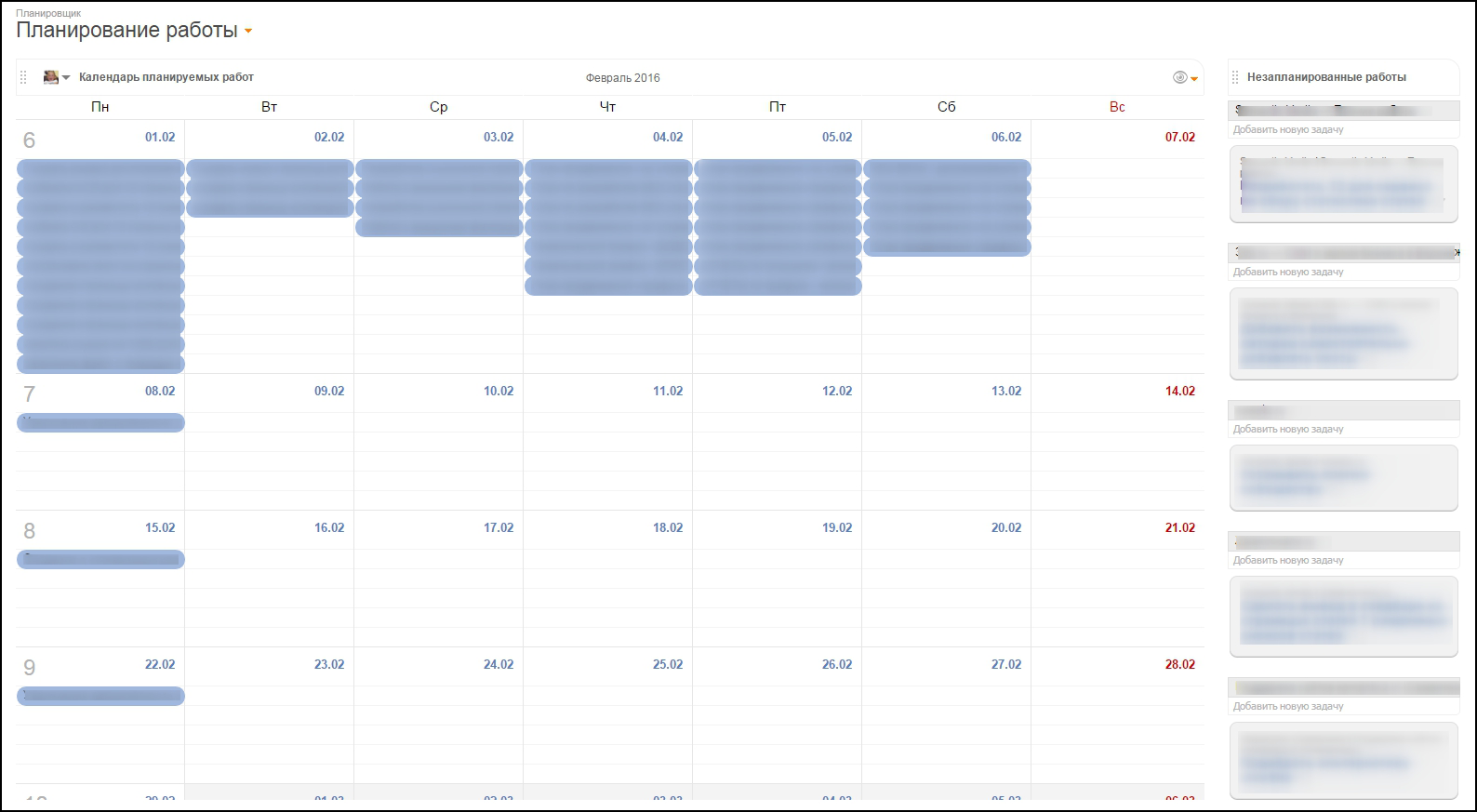
You can add unscheduled events or jobs of lower priority to empty time blocks. In cases where the amount of work is greater than the amount of time, work can be planned several days in advance. But you should not abuse this, otherwise there may be delays in the execution of high-priority tasks. And given that low-priority work may increase in priority over the following days, all tasks should be completed in a timely manner.
For you need to correctly set priorities and act in accordance with them. The project manager should not be distracted by secondary and fuzzy tasks and procrastinate in making important decisions. He must also be able to delegate authority.
And the last thing we will focus on in the first lesson is some organizational points.
Organization of work on project planning
Project planning is the process of generating decisions that determine the sequence of project work and activities. It plays a dominant role in project management, representing the organizing beginning of the project implementation process.
Project planning includes several stages:
- Setting goals and objectives
- Resource calculation
- Create a schedule for the duration of work
- Work schedule optimization
- Organization of work execution
- Creation of a calendar plan for increasing the labor intensity of work
- Work progress control
- Correction of the progress of work
The project implementation plan is a comprehensive plan containing a comprehensive system of tasks and goals, detailed works, actions and activities to achieve the main goal of the project. Great care must be taken in the preparation of the implementation plan, trying to avoid common mistakes such as:
- Setting the wrong goals
- Use of incomplete information
- Ignoring past experience
- Ignoring the issue of resource availability
- Lack of attention to the coordination of project participants
- Ignoring the motivation of performers
- Excessive attention to plan detail
- Making a plan for the sake of the plan and ignoring the control of following the plan
Despite the rather large number of errors and their specificity, taking into account all the planning elements that we have told you about helps to bypass them. It is only important to remember that project planning is a systematic ordering of tasks, the purpose of which is to achieve the main result - the implementation of the project. And taking into account the fact that the plan always contains instructions for actions and the actions themselves, it can be safely considered a standard or benchmark against which actual indicators will be compared. If, as a result of such comparisons, any discrepancies are found, it is necessary to take measures to adjust the plan.
In the second lesson, we will talk about another important element of project management for a leader - team management. Issues such as the composition of the project participants, the functions of the project manager, the features of the formation and development of the project team, the characteristics and composition of the team, conflict resolution and a number of others will be considered.
Test your knowledge
If you want to test your knowledge on the topic of this lesson, you can take a short test consisting of several questions. Only 1 option can be correct for each question. After you select one of the options, the system automatically moves on to the next question. The points you receive are affected by the correctness of your answers and the time spent on passing. Please note that the questions are different each time, and the options are shuffled.



